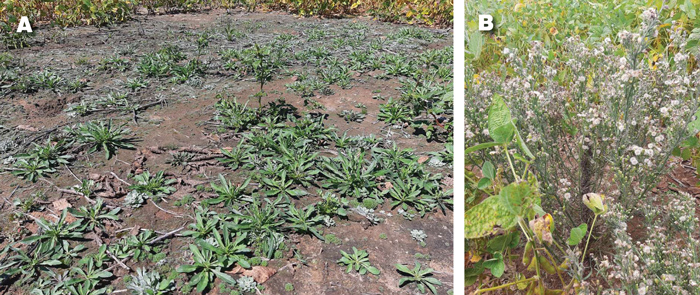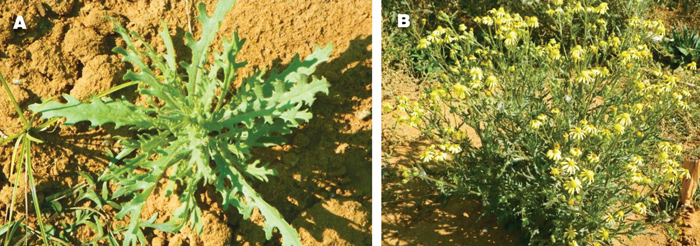July 2022
| DR MARYKE CRAVEN, SENIOR RESEARCHER, ARC-GRAIN CROPS |
 |
Winter annual weeds are weeds that can germinate during the autumn and live throughout the winter. These weeds continue to mature, flower and set seed during the spring and then die during the summer.
Fleabane (Conyza spp) and ragwort (Senecio consanquineus) are common examples of winter annual broadleaf weeds. Winter weeds are well adapted to winter conditions and therefore could utilise large quantities of water during their lifespan. During the spring, the rainfall is limited. Winter weeds will then continue to dry the soil to such an extent that the germination of crop seeds is delayed.
In areas where the winter weed population is dense, a crop will emerge particularly slow or not at all. Winter annual weeds can also serve as hosts to various diseases such as Sclerotinia sclerotiorum (sclerotinia stalk rot of soybean), insects such as cutworm and nematodes that have a negative impact on the yield of the following summer crop.
WINTER WEED CONTROL
General aspects to remember with winter annual weed control are:
Control of fleabane and ragwort
Effective control of both fleabane (Figure 1) and ragwort (Figure 2) can be achieved by shallow cultivation and herbicide application on younger, smaller plants during late March or early April. However, since the summer crops are still present in the fields when these weeds start to germinate, the use of a herbicide may be problematic.

Figure 1: Fleabane plants at seedling and rosette phase (A) and at flowering (B).

Figure 2: Young (A) and flowering ragwort plant (B).
The application of such herbicides between rows (directed) using knapsack sprayers in smaller areas or drop arms in larger areas is possible during this period. Producers with ordinary tractor sprayers will only be able to apply these herbicides post-harvesting, when they can enter the fields.
Ragwort can be sprayed post-harvest with a systemic herbicide such as glyphosate or a contact herbicide such as paraquat. In the presence of fleabane, the most effective control is generally achieved with a tank mixture of glyphosate combined with a second herbicide with another mode of action such as 2,4-D or atrazine, depending on the follow-up summer crop (residual effects).
Farmers are welcome to contact Dr Craven on 018 299 6346 for more information.
Important: It remains imperative that farmers adhere strictly to the recommendations on product labels in terms of the specific weeds that can be controlled, the crop(s) on which the herbicide is registered, the dosage rates to be used and any residual effects the herbicide might have. Farmers should contact a reliable chemical advisor to help them choose the most effective herbicide for their specific needs and to indicate which dosage rate to apply.
Publication: July 2022
Section: Pula/Imvula